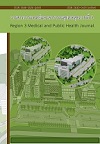Prevalence and Risk Factors for Recurrent Febrile Seizures after First Episode of Febrile Seizure in Pediatric Patients at Sawanpracharak Hospital
Keywords:
Febrile seizure, Prevalence, Risk factors, PediatricAbstract
Objective : To study prevalence and risk factors for recurrent febrile seizures (FS) after having the first seizure in pediatric patients at Sawanpracharak Hospital.
Method : This study was a retrospective cohort study in pediatric patients, aged from 6 months to 5 years old, who were diagnosed with initial FS at Sawanpracharak Hospital between January 2015 to December 2017. 255 patient medical records in the databases were revised. Statistics used to estimate was the rate of recurrent FSs with the binomial distribution theory. The recurrence rate was reported in percentage and 95% CI. The logistic regression was used to find risk factors for recurrent FSs and the level of statistical significance was determined at p-value < 0.05.
Results : The median age of pediatric patients with FSs was 18.1 (IQR 11.2-27.6) months, mainly males 58.8%. Fifty-eight of them (22.7%) had recurrent FSs after an initial seizure. The age of patients with the first seizure of less than 24 months (OR, 2.47; 95%CI, 1.11-5.51; p=0.03) and the complex type of first seizure (OR, 2.28; 95% CI, 1.12-4.64; p=0.02) were statistically significant risk factors for recurrent FSs after the first seizure. Acute pharyngitis was the most common cause of the first and second seizures. Gender, body temperature during the first seizure, duration of fever prior to an initial seizure, family history of FSs and epilepsy were not risk factors for recurrent FSs.
Conclusion : Apart from monitoring, knowledge and advice should be given to parents of seizure patients, especially in groups at risk of recurrent febrile seizures, so parents can provide proper care, lead to reduce concerns and various complications that may occur in children.
Keywords : Febrile seizure, Prevalence, Risk factors, Pediatric
References
มัยธัช สามเสน. แนวทางการปฏิบัติในการดูแลเด็กที่มีอาการชักจากไข้ (Febrile seizure). ใน: กาญจนา อั๋นวงศ์, บรรณาธิการ. แนวทางการรักษาโรคลมชักสำหรับแพทย์ Clinical Practice Guidelines for epilepsy. กรุงเทพฯ: ธนาเพรส; 2559. หน้า 58-62.
Capovilla G, Mastrangelo M, Romeo A, Vigevano F. Recommendations for the management of “febrile seizures”: Ad Hoc Task Force of LICE Guidelines Commission. Epilepsia 2009;50 Suppl 1:2-6.
สุมิศรา อารีย์วัฒนานนท์. ปัจจัยที่มีผลต่อการเกิดไข้ชักซ้ำในผู้ป่วยเด็กโรคไข้ชักครั้งแรกของโรงพยาบาลหนองคาย. วารสารโรงพยาบาลมหาสารคาม 2559;13(3):119-228.
Maksikharin A, Prommalikit O. Recurrent rates and risk factors of febrile seizures in the subsequent illness following the first febrile seizures in Thai children. J Med Assoc Thai 2019;102:62-6.
Berg AT, Shinnar S, Hauser WA, Alemany M, Shapiro ED, Salomon ME, et al. A prospective study of recurrent febrile seizures. NEJM1992;327:1122-7.
Canpolat M, Per H, Gumus H, Elmali F, Kumandaş S. Investigating the prevalence of febrile convulsion in Kayseri, Turkey: an assessment of the risk factors for recurrence of febrile convulsion and for development of epilepsy. Seizure 2018;55:36-47.
Km R, Ranhotra A, Kanodia P, Ahmad S, Gupta V. Evaluation of febrile seizures in NGMC and assessment of risk factors for recurrences. JNGMC 2018;14:30-3.
Manika J, Rachmi E. A description of risk factors of recurrent febrile seizure on pediatric patients in Abdul Wahab Sjahranie Hospital in Samarinda. JIK 2020;8:17-20.
Steering Committee on Quality Improvement and Management, Subcommittee on Febrile Seizures American Academy of Pediatrics. Febrile seizures: clinical practice guideline for the long-term management of the child with simple febrile seizures. Pediatrics 2008 ;121(6):1281-6. doi: 10.1542/peds.2008-0939. PMID: 18519501.
Indriani A, Risan N, Nurhayati T. Five years study of recurrent febrile seizure risk factors. AMJ 2017;4(2):282-5.
Agrawal J, Poudel P, Shah GS, Yadav S, Chaudhary S, Kafle S. Recurrence risk of febrile seizures in children. J Nepal Health Res Counc 2016;14:192-6.
Kumar N, Midha T, Rao YK. Risk factors of recurrence of febrile seizures in children in a tertiary care hospital in Kanpur: a one year follow up study. Ann Indian Acad Neurol 2019;22:31-6.
Renda R, Yüksel D, Gürer YK. Evaluation of patients with febrile seizure: risk factors, recurrence, treatment and prognosis. Pediatr Emerg Care 2020;36:173-7.
Kliegman R. Nelson textbook of pediatric. 20th Ed. Philadephia: Elsevier; 2016.
Kantamalee W, Katanyuwong K, Louthrenoo O. Clinical characteristics of febrile seizures and risk factors of its recurrence in Chiang Mai University Hospital. Neurol Asia 2017;22(3):203-8.
Downloads
Published
How to Cite
Issue
Section
License
Copyright (c) 2022 เขต3 และโรงพยาบาลสวรรค์ประชารักษ์

This work is licensed under a Creative Commons Attribution-NonCommercial-NoDerivatives 4.0 International License.



